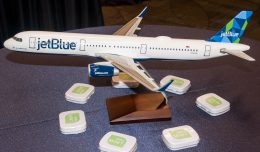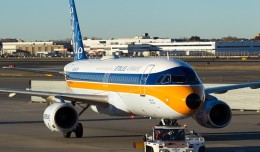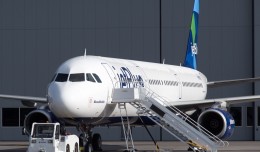WiFi is one of the most requested demanded in-flight features, even though it has only existed for a few short years. A recent survey even showed that 90% of passengers would trade some other amenity to have reliable WiFi in the sky. More and more passengers are seeing that little WiFi logo on their plane, but not all systems are created equally. In-flight WiFi systems can vary from unbearably slow to as fast as your home connection. Let’s break down the different types of in-flight Wi-Fi technology, and where you can find each one.
Air-To-Ground
Air-To-Ground, or ATG, is by far the most popular technology for in-flight WiFi in North America, and is used by Gogo. As the name suggests, it utilizes base stations on the ground, similar to cell phone towers, rather that incredibly expensive satellites. The backbone of the system, EVDO, is even based of the same cellular technology that Sprint and Verizon use for their 3G services. The original Gogo network, which the bulk of aircraft still use, is capable of about 3Mbps per aircraft. When you split 3Mbps up between 50 people on a 757, the results aren’t pretty.
Enter ATG-4. Launched last year by Virgin America, ATG-4 bumps up the system speed to about 10Mbps per aircraft. Better, but still not great. This week, Gogo detailed their next generation system, which leverages their ATG-4 network, plus a Ku-band satellite down additional downlink speeds. This hybrid solution brings the entire system to a claimed maximum of 60Mbps, which is a big improvement.
You can find Gogo service on Virgin America, US Airways, American Airlines, United, Frontier, Delta, Alaska Airlines, AirTran, and Air Canada.
L-Band Satellite
L-band, which refers to satellite signals in the 1-2Ghz range, is not what you want to be using in-flight. The system uses Inmarsat’s SwiftBroadband service, and managed by OnAir. While the satellite dish and radome on the aircraft are small, which equates to less fuel burn, the system is about as fast as a really bad 3G connection…shared by the entire aircraft. Running at either 432 kbit/s or 864 kbit/s depending on the specific configuration, this system will grind to a stop with just a few passengers using it. Some airlines have given up on L-band, and either abandoned it for other solutions, or never expanded service beyond a limited trial.
You can find (and avoid) L-band on most Emirates A380s, one Finnair aircraft (OH-LTT), Singapore, Iberia, Etihad, Aeroflot (A330), and more. For a full list, check here.
Ku-Band Satellite
Ku-band, situated in the 12-18 GHz range, is a major step up from L-band. With an claimed maximum rate of 50Mbps (though real world results vary quite a bit), a Ku-band system is currently your best bet on an international flight for service you can actually use. Ku-band connections are even fast enough to send a few channels of live TV to flights overseas, which is a first. Still, though, you almost certainly won’t be streaming Netflix or browsing YouTube with this system. Ku-band is offered by a wide variety of companies, ranging from Panasonic, to Gogo, to Row44.
Ku-band connections can be found on a majority of Southwest flights, Allegiant Air, Icelandair, Norwegian Air Shuttle, Transareo, UTair, Turkish, newer Emirates 777s, Garuda Indonesia, Singapore, United, coming soon to Delta longhaul, and a few other airlines.
Ka-Band Satellite
Ka-band, higher up in the spectrum at 26.5–40 GHz, promises the absolute fastest in-flight WiFi money can buy…once it finally goes live. While no airline currently uses Ka-band connections, that will change within weeks (or months) once JetBlue gets their long awaited system in the air. Ka-band promises much higher speeds than Ku-band systems, and will absolutely leave L-band in the dust. “Exede by ViaSat,” which will come to JetBlue and select United aircraft, promises 12Mbps to each passenger, not the aircraft itself. Other company’s plan to offer Ka-band in the future, but it will come first to JetBlue and United with ViaSat.







